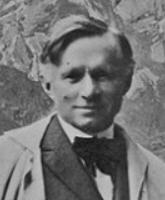
William Wendt (1865-1946) is widely regarded as one of the most influential American artists of the early 20th century and the most important artist from the art colony of Laguna Beach, California. What is unusual for an artist of his stature is that what we know of him comes from second and third-hand contemporary accounts; Wendt left no diary, no scrapbook and very few papers, and had no children.
What we do know is that he was born in Germany in 1865, emigrated to Chicago at 15 and worked as a commercial painter. He enrolled in the Bromlet School of Art, and later studied at the Art Institute. In 1893, he quit his job, becoming a full-time painter in his studio. His talent was soon recognized, and in the same year, he won the Second Yerkes Prize in the Chicago Society of Artists Exhibition at the Art Institute. The prize was $200, which financed his first trip to California.
He held his first major show in Chicago in 1901 and sold half of the exhibited works—and even one to Frank Lloyd Wright, an early admirer. At this time, due to his training and current artistic trends, he was painting in the Barbizon and Impressionist styles. This was soon to change, when in 1906 he married the artist Julia Bracken and moved to Los Angeles.
Wendt was a natural leader and educator—in 1911 he became President of the California Art Club, a position he would hold for many years. He was instrumental in admitting women to the organization and was key in educating the public. Wendt arranged traveling exhibitions of works to San Francisco and also organized exhibitions at public libraries, bringing in school children from surrounding districts, and holding public nightly lectures around the exhibitions.
In 1918, Wendt built a studio in Laguna Beach and moved there, his wife remaining at their Los Angeles home. He became relatively reclusive, withdrawing from public life. There have been several suggestions as to the reason—it may have been partly due to his German heritage, as the onset of War lead to a wave of anti-German sentiment in America. Another observation was that he suffered from depression for many years, and a final theory was that he was escaping the encroaching industrialization and urban expansion that was destroying the California landscape; perhaps all three were true. In any case, he remained remarkably prolific until the last 10 years of his life, painting only 30 works during that period.
Wendt was a religious man. He was exposed to the Swedenborgian concept that nature was a manifestation of God and that all things in nature correspond to spiritual reality; the artist was simply nature’s interpreter. When looking at Wendt’s paintings, only rarely do we see people, animals, buildings, roads or bridges. Wendt was known to edit out such things, as he believed that tourism and industry were rapidly changing the environment—he felt that land was the central and most important source of human happiness. What we also see is that the sky plays a secondary role in the overall painting, usually taking up less than a third of the canvas—all attention is drawn to the landscape. When viewing a William Wendt painting, we feel, either consciously or unconsciously, a stillness and sense of serenity, simply nature on a grandiose scale.